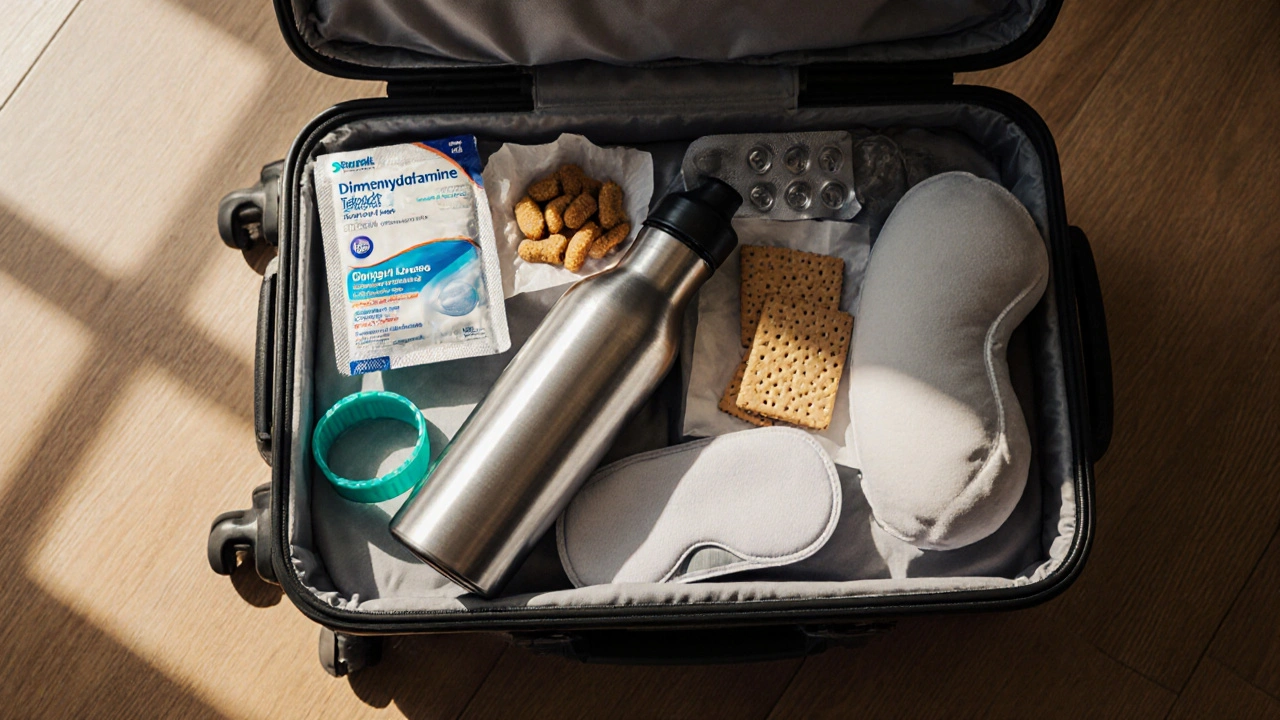Motion Sickness Medication Selector
Your Recommendation
When you plan a getaway and you’re prone to motion sickness, the right prep can turn a potential nightmare into a smooth ride.
Quick Takeaways
- Start medication 1‑2hours before you travel - the earlier, the better.
- Choose seats over the wings on a plane, in the middle of a car, or near the center of a boat.
- Pack ginger chews, acupressure wristbands, and plenty of water.
- Eat a light, bland meal and stay hydrated to keep your stomach settled.
- Practice controlled breathing and visual focus if symptoms appear.
What Triggers Motion Sickness?
Motion sickness is a mismatch between the signals your vestibular system sends and what your eyes see. When your inner ear detects movement that your sight doesn’t confirm, the brain interprets the conflict as a toxin entering the body, sparking nausea and dizziness.
Common culprits include sudden turns, turbulence, reading while in motion, and an empty or overly full stomach. Knowing the why helps you target the how.

Pre‑Trip Medication Strategy
Over‑the‑counter options work well for most people if taken correctly.
| Medication | Onset | Duration | Best For | Typical Side Effects |
|---|---|---|---|---|
| Dimenhydrinate | 30‑60min | 4‑6hr | Short trips, car rides | Drowsiness, dry mouth |
| Meclizine | 1‑2hr | 24hr | Long flights, cruises | Light‑headedness, blurred vision |
| Scopolamine Patch | 4‑6hr (apply night before) | 72hr | Extended trips, multi‑day tours | Dry eyes, mild confusion |
| Ginger Supplements | 15‑30min | 2‑3hr | Gentle relief, children | Rare heartburn |
Take your chosen pill with a light snack, not on an empty stomach. For the scopolamine patch, apply it behind the ear at least four hours before boarding - the medication diffuses through the skin right into the bloodstream.
Smart Seat & Transport Choices
Where you sit can cut the intensity of motion cues.
- Planes: Seats over the wings experience the least vertical movement.
- Cars: The middle of the back seat, preferably the passenger side, offers the most stable view.
- Boats: Position yourself near the centerline and as low as possible.
- Trains: Choose seats facing forward and near the middle car.
Facing forward aligns your visual input with the direction of travel, reducing the brain’s confusion.
Essential Packing List
Bring a small “sickness kit” that fits in a carry‑on.
- Dimenhydrinate or your preferred tablet.
- Scopolamine Patch (if you need long‑term coverage).
- Ginger candies or chews - they’re easy to munch during a motion‑heavy segment.
- Acupressure wristband - press‑on pressure points on the inner forearm.
- Reusable water bottle - sip frequently to stay hydrated.
- Pack of plain crackers or toast - a bland snack can calm an unsettled stomach.
- Travel pillow and eye mask - comfort aids reduce overall stress, which can worsen nausea.
Keep the kit in an easily reachable pocket so you don’t scramble when symptoms start.

During the Journey: Managing Symptoms
If you feel queasy despite preparation, try these immediate tactics.
- Controlled breathing: Inhale through the nose for four counts, hold two, exhale through the mouth for six. Repeat until the nausea subsides.
- Visual focus: Look at a fixed point on the horizon or the cabin ceiling. Avoid reading or scrolling on a phone.
- Pressure point press: Use your thumb to press the inner wrist (about two finger‑widths below the base of the palm) for 30 seconds.
- Cool air: Direct the air vent toward your face. A cold breeze can reset the body’s equilibrium.
- Stay still: If possible, keep your head upright and avoid sudden head movements.
Combine two or three of these tricks for best results. If nausea persists, take a second dose of medication as directed - but don’t exceed the recommended daily limit.
After Arriving: Recovery and Prevention for the Next Day
Give your body a chance to rebalance.
- Drink a glass of water mixed with a pinch of salt - it helps restore electrolytes lost through sweating.
- Eat a balanced meal with protein, complex carbs, and a small amount of healthy fat to keep blood sugar stable.
- Take a short walk in fresh air; movement can recalibrate the vestibular system.
- Rest - even if you feel fine, a good night’s sleep reduces the likelihood of lingering sensitivity.
Note any patterns - certain routes or times of day may be more problematic. Adjust future plans accordingly.
Frequently Asked Questions
Can I take motion‑sickness medication if I’m pregnant?
Most OTC options like dimenhydrinate are not recommended during pregnancy without a doctor’s approval. Ginger is generally considered safe in moderate amounts, but always check with your healthcare provider first.
What’s the best natural remedy for quick relief?
Fresh ginger or ginger chews work fast for many people. Chewing a small piece of raw ginger or sipping ginger tea 20‑30 minutes before travel can reduce nausea by up to 40%.
Should I avoid coffee before a trip?
Caffeine can dehydrate you and may worsen symptoms for some. A small cup is fine, but balance it with extra water.
Is it okay to read on a train if I have motion sickness?
Reading increases visual‑vestibular conflict, so it usually makes nausea worse. Try listening to an audiobook or looking out the window instead.
How long does the scopolamine patch stay effective?
One patch releases medication for up to 72hours, so a single application can cover a long‑haul flight plus a couple of days of ground travel.
With the right prep, motion sickness won’t dictate your itinerary. Follow the steps, pack the right gear, and enjoy the journey.

allen doroteo
October 12, 2025 AT 06:56Honestly, this whole "sit over the wing" advice is just a myth-I've never felt a thing, even in the worst turbulence. The meds are overkill, and the ginger chews taste like cheap candy. Everyone's scared for no reason.